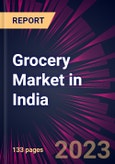Speak directly to the analyst to clarify any post sales queries you may have.
The report offers an up-to-date analysis regarding the current market scenario, the latest trends and drivers, and the overall market environment. The market is driven by rapid growth in m-commerce, increased popularity and rise in e-commerce platforms, and rise in disposable income among consumers in india.
The study was conducted using an objective combination of primary and secondary information including inputs from key participants in the industry. The report contains a comprehensive market size data, segment with regional analysis and vendor landscape in addition to an analysis of the key companies. Reports have historic and forecast data.
The grocery market in india is segmented as below:
By Platform
- Offline
- Online
By Product
- Food grains
- Bread bakery and dairy products
- Fruits and vegetables
- Personal care
- Others
By Method
- Online payments
- Cash on delivery
The report on the grocery market in india covers the following areas:
- Grocery Market in India sizing
- Grocery Market in India forecast
- Grocery Market in India industry analysis
The report presents a detailed picture of the market by the way of study, synthesis, and summation of data from multiple sources by an analysis of key parameters such as profit, pricing, competition, and promotions. It presents various market facets by identifying the key industry influencers. The data presented is comprehensive, reliable, and a result of extensive primary and secondary research. The market research reports provide a complete competitive landscape and an in-depth vendor selection methodology and analysis using qualitative and quantitative research to forecast accurate market growth.
Table of Contents
Executive Summary
The following companies are recognized as the key players in the grocery market in india: Amazon.com Inc., Avenue Supermarts Ltd., B L Agro Industries Ltd., Blink Commerce Pvt. Ltd., Bundl Technologies Pvt. Ltd., Dunzo Digital Pvt. Ltd., FRESHTOHOME FOODS Pvt. Ltd., Heritage Foods Ltd., Innovative Retail Concepts Pvt. Ltd., LuLu Hypermarket, Metro Cash and Carry India Ltd., More Retail Pvt. Ltd., Natures Basket Ltd., Ondoor Concepts Pvt. Ltd., Pincode Shopping Solutions Pvt. Ltd., Reliance Retail Ltd., SPAR Group Inc., Spencer Retail Ltd., Walmart Inc., and Zepto.Commenting on the report, an analyst from the research team said: "The latest trend gaining momentum in the market is growth in demand for functional foods and beverages."
According to the report, one of the major drivers for this market is the rapid growth in m-commerce.
The study was conducted using an objective combination of primary and secondary information including inputs from key participants in the industry. The report contains a comprehensive market and vendor landscape in addition to a SWOT analysis of the key vendors.
Companies Mentioned (Partial List)
A selection of companies mentioned in this report includes, but is not limited to:
- Amazon.com Inc.
- Avenue Supermarts Ltd.
- B L Agro Industries Ltd.
- Blink Commerce Pvt. Ltd.
- Bundl Technologies Pvt. Ltd.
- Dunzo Digital Pvt. Ltd.
- FRESHTOHOME FOODS Pvt. Ltd.
- Heritage Foods Ltd.
- Innovative Retail Concepts Pvt. Ltd.
- LuLu Hypermarket
- Metro Cash and Carry India Ltd.
- More Retail Pvt. Ltd.
- Natures Basket Ltd.
- Ondoor Concepts Pvt. Ltd.
- Pincode Shopping Solutions Pvt. Ltd.
- Reliance Retail Ltd.
- SPAR Group Inc.
- Spencer Retail Ltd.
- Walmart Inc.
- Zepto








